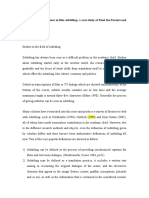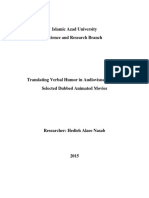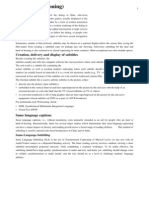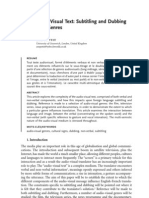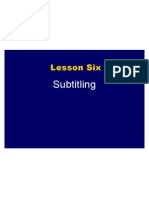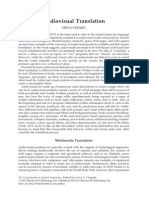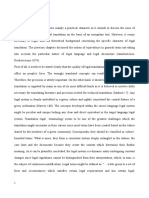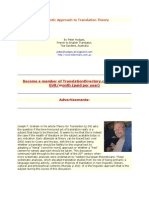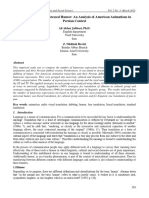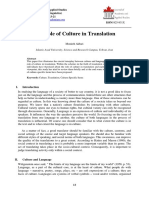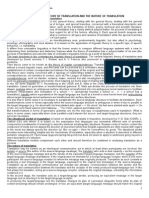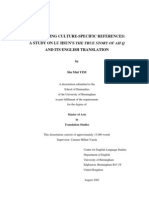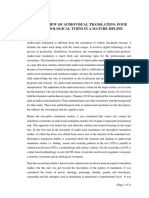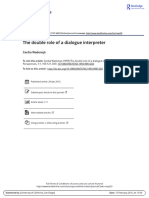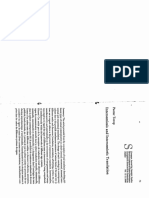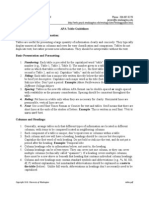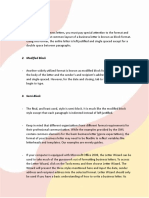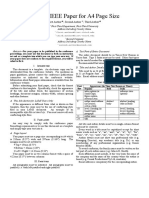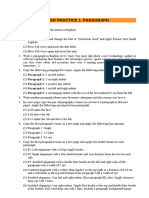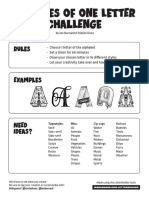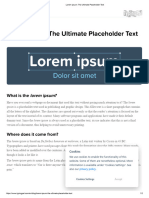MA in Translation & Interpreting – Helen J Lever
3.0 CHAPTER TWO – SUBTITLING
This chapter will look at the concept of subtitling. Definitions will be
provided of the main concepts and an explanation of the general theory
behind subtitling will be given. Discussion will then move on to a more
detailed analysis of the constraints associated with subtitling and the
implications in terms of translation. Finally, the impact of these constraints
on cultural features will be examined, paying particular attention to the
elements of culture outlined in the previous chapter, namely dialect and
accent.
Subtitles can be defined as ‘transcriptions of film or TV dialogue, presented
simultaneously on the screen’.1 The types of subtitling available can be
divided into two categories: intralingual and interlingual subtitling.
Intralingual subtitling deals with the production of subtitles that remain in
the same language as the original and are used for the deaf or hard of
hearing, or for language learners. Henrik Gottlieb describes it as vertical,
‘in the sense that it involves taking speech down in writing, changing mode
but not language.’2 Interlingual subtitling, on the other hand, refers to both
a change in mode and language, going ‘from one language into another
language, and from spoken dialogue into a written, condensed translation
which appears on the screen.’3 Therefore, for the purposes of this work,
“subtitling” will refer to the interlingual subtitling described above.
- 30 -
� MA in Translation & Interpreting – Helen J Lever
When looking at subtitling, from the point of view of translation, many
constraints exist that will effect the translation in question and cause the
translator to modify the source text to a certain degree. Firstly, there are
synchronisation constraints, which affect a number of aspects of language
transfer. The very fact that the medium changes from oral to written will
cause problems, given that it generally takes longer to process information
received through the eyes than through the ears. So, if, in the spoken text, a
large amount of information is provided, in the subtitles it will be necessary
to modify the way this information is presented without losing any of it, in
order to simplify the delivery and account for the change of medium.
Similarly, if the length of certain utterances is too great or the structure too
complex, it will be necessary to make some modifications in order to
facilitate understanding through the written format. A long, complex
sentence, although easy to comprehend if heard, would be very difficult to
follow if it were left unaltered, given the timeframe available to read
subtitles. For example, if we take the following narration as the spoken
version of a text:
“In beautiful autumnal colours, the stunning models glided around the
splendid arena, oozing sophistication and elegance, doing rightful
justice to the imaginative designers.”
the subtitled written would more than likely be rendered in a more simplistic
fashion, such as :
- 31 -
� MA in Translation & Interpreting – Helen J Lever
“In the arena the designers’ outfits were modelled with style and
elegance.”
This also relates to the reading speed of the viewer, which needs to be
taken into consideration. Clearly, establishing the profile of the target
audience will be crucial in assessing the viewer’s potential reading speed
and is an important factor for the translator. In this aspect, literacy and age
are both influencing factors. For example, there is likely to be a great deal
of difference between an adult’s and a child’s reading speed, and, as such,
the subtitles would need to be altered accordingly, for example, by
simplifying the vocabulary for a child. Also, if the subtitled version of a
broadcast were to be shown in a country with a low level of literacy, it
would be necessary to ensure the subtitles were fairly basic. So, ‘an
accurate assessment of audience literacy and of the viewers’ knowledge of
the subject matter is therefore essential to the success of subtitling’.4
Another constraint, in terms of synchronising the subtitling, is the
correlation with the visuals on-screen and the sound track. In other words,
the subtitles must link up with what the viewer is seeing and hearing on the
screen, so they are able to maintain their coherence. This is especially
important if the translator is dealing with a visual gag or comedy element, in
which case it would not be correct to spoil the surprise before the joke has
happened. The same would apply in a “whodunit” type of scene, where it is
vital to the story for the viewer not to be aware of a clue or perhaps the
identity of a culprit until the appropriate moment. Frame changes represent
another constraint to the translator. If a subtitle appears over a frame
- 32 -
� MA in Translation & Interpreting – Helen J Lever
change, it is likely that the subtitle will be lost to the viewer, as their
attention is likely to be diverted away from the subtitle, due to the change in
scene. Therefore, the translator must ensure that the subtitles have
disappeared from the screen by the time the frame changes. However,
sometimes this is not always possible. As Josephine Dries points out, ‘a
good subtitler will wish to avoid a subtitle staying on screen across a shot
change, and certainly across a scene change. When cuts follow each other
too quickly, the minimum reading time (in most countries 1 ½ seconds, in
some 1 second) sometimes forces the subtitlers to break this law’.5 A final
constraint, which must be accounted for, involves the medium through
which the subtitles are to be shown, which, in turn, will affect factors such
as font size and audience age range. In cinemas, for example, the size of the
screen is much larger and therefore, will allow more flexibility with regard
to the font size of the subtitles, making the reading of them easier and more
comfortable for the viewer, whereas, on television, the translator is
restricted to a smaller screen space, thereby limiting the size of the font.
Also, the type of audience likely to be attracted by these two mediums will
differ, in which case the translator’s task is made more difficult as they are
less likely to be able to assess the reading speed and literacy of the audience.
However, as Ivarsson and Carroll point out, ‘whatever the medium, the
principle of maximum legibility always applies’.6
Secondly, throughout this discussion, it is clear that there are two main
factors relevant to achieving successful subtitling: legibility and readability
or simplicity. Strategies have been developed focusing on these two
- 33 -
� MA in Translation & Interpreting – Helen J Lever
elements, in order to provide suitable guidelines for subtitlers. First of all,
let us look at legibility. To achieve legibility, subtitlers must focus on the
appearance of the subtitles and the timing. With regard to the appearance of
the subtitle, for languages that read left to right, the positional options are
for text to be either centred or left-aligned. Historically, subtitles had
always been centred, mainly due to the poor quality of television sets, which
tended to be fuzzy round the edges. So, in order not to lose any of the text,
they were positioned in the centre of the screen. However, as technology
has improved and, so, presents fewer restrictions, today’s convention
favours more the left-aligned approach, as it is suggested that it is easier for
the eye to focus on a new line if it begins in the same spot on the screen. In
other words, the viewer is likely to read more quickly if his or her eyes are
not continually having to dart around the screen to find the beginning of the
speech. The position of the subtitle is something that can be accounted for
when a programme is in its production stage, especially if the producers are
aware that the production is going to be exported and, therefore, subtitled.
In her guidelines for production, Josephine Dries suggests that ‘since the
subtitles usually cover the lower 15% (two lines) of the screen, care should
be taken that the mouth of the speaker is slightly higher on the screen than it
would normally be. Viewers focus on the moving part of the picture, i.e. the
mouth in a close-up, which should not be covered by the subtitle’.7
As well as the position of the subtitles, the number and length of the lines
appearing on screen at any one time must be taken into consideration. The
general consensus is that two lines of subtitles should be the maximum to
- 34 -
� MA in Translation & Interpreting – Helen J Lever
appear on the screen at the same time. In fact, this point is included in the
“Code of Good Subtitling Practice” developed by Ivarsson and Carroll for
discussion at the ‘Languages and the Media’ conference in Berlin, October
15-16, 1998. Point 19 states ‘the number of lines in any subtitle must be
limited to two’8. However, this is considered as the maximum limit not the
preferred option. It is suggested, therefore, that ‘if it is possible to write the
text of any one subtitle in a single line, it is usually better to do so’. 9 Of
course, the medium for which the subtitles are intended will also have an
impact on this, as the size of the cinema screen may justify having two lines
rather than one. This, then, leads on to the issue of the line breaks. If there
are two lines of subtitles, where should the break between them occur?
Generally, one line of subtitle should have between 35-40 characters, which
implies that a lengthier subtitle will need a break at some point. As such,
one line is likely to be longer than the other. Here, there is a connection
with the position of the subtitle on the screen, as discussed earlier. If the
subtitles are centred, it does not matter which of the lines is longer, as the
distant the eye must travel to look at the beginning of the second line will be
the same either way round. However, if the subtitles are left-aligned, the
eye will have much further to move if the first line is much longer than the
second, in which case it is better for the first line to be the shorter of the
two. This is clearly illustrated, by Ivarsson and Carroll, in the following
diagram:10
- 35 -
� MA in Translation & Interpreting – Helen J Lever
e.g. Centred:
He said that he would not be able to come
until tomorrow.
He said
that he would not be able to come until tomorrow.
Left-aligned:
He said that he would not be able to come
until tomorrow.
He said
that he would not be able to come until tomorrow.
In either case, it is very important that the line break does not affect the
meaning of the subtitle, by splitting the sentence in such a way as to alter
the viewer’s understanding of what is being said.
The typeface or font used for the subtitles needs, also, to be considered.
Very ornate fonts are usually quite difficult to read whatever the medium,
and, so, would be especially difficult in a subtitle format, particularly on the
small screen. Also, text written in uppercase tends to be harder to read than
text written in the standard lowercase and uppercase structure. Therefore, it
is necessary, in order to enhance legibility, to make sure the subtitles are
presented in a basic, simple font, in the standard lowercase / uppercase
format. The use of italics is often introduced to denote a distant voice, a
voice on the telephone or off screen, quotes or internal voices such as those
- 36 -
� MA in Translation & Interpreting – Helen J Lever
in dreams or flashbacks. As such, it is important that they are reserved for
this specific use, in order not to confuse the viewer.
The colour of the subtitle on the screen will also affect its legibility, in
comparison to the background on which it is set. Clearly, if the subtitle is in
white and there is a lot of white or light-coloured background, the subtitle
will not stand out sufficiently to be seen, let alone read. Likewise, the same
would apply for black subtitles on dark or black backgrounds.
Unfortunately, it is unlikely that the same level of darkness will appear in
the background throughout the film. Therefore, one possibility is to place a
box behind the subtitles to contrast against the colour of the text. However,
the technology available to the subtitler or production team will determine
whether or not this is a feasible option. As point 3 of the technical aspects
of the “Code of Good Subtitling Practice” states, ‘in video applications,
character clarity can be enhanced by a drop shadow or semi-transparent or
black box behind the subtitles.’11
Finally, punctuation is a feature of the appearance of the subtitle that needs
to be addressed, as it can easily distract the viewer and distort the meaning
of the utterance. As such, it is best to keep punctuation to a minimum and
to strike a fair balance between providing enough punctuation for the viewer
to understand the meaning and providing too much for it to become a
distraction. As an example, let us look at the following two sentences:
“He said, “I can’t come ‘til 6 o’clock!”
“He said he can’t come until 6.00 pm”
- 37 -
� MA in Translation & Interpreting – Helen J Lever
If we take into consideration the amount of time the subtitle is to remain on
the screen, reading speed etc. then it is clear that the second sentence will be
easier to read as the unnecessary punctuation has been removed and,
therefore, does not cause a distraction. In some cases, however, it is
necessary to include punctuation, for example, when two different people
are speaking, which is often denoted by a dash “ – ” separating the two
speakers. In essence, Luyken sums it up by saying ‘distractions such as
complex sentences, abbreviations, unnecessary punctuation, incomplete
sentences and ambiguities (unless reflecting ambiguity in the source) must
be avoided’.12
The second area relevant to achieving legibility is that relating to timing.
Unfortunately, it is very difficult to set fixed timings for subtitling, as there
are a number of factors that can impact on reading behaviour, such as ‘the
level of literacy of the target audience, the viewer’s degree of familiarity
with the programme language, the genre of the subtitled programme and the
pace of the visuals’.13 However, firstly, in terms of the length of time one
subtitle should remain on the screen, guidelines have been proposed
suggesting that somewhere between one and seven seconds would be
appropriate. Again, this will depend on the factors mentioned but also on
the length of the subtitle, whether it is one or two lines, a short or a long
utterance. In relation to this, Ivarsson and Carroll have suggested the
following:
‘As a general rule, the minimum time for even a very short subtitle on
a television screen is at least one and a half seconds and the maximum
- 38 -
� MA in Translation & Interpreting – Helen J Lever
time for a full two-liner should not exceed five to six seconds. A full
one-liner should be kept on the screen for about three seconds, one and
a half lines for about four seconds.’14
They, also, go on to comment that if a subtitle is left on the screen for too
long, the viewer is then tempted to read it more than once, thereby
destroying the sense of a flowing dialogue. On the other hand, if the subtitle
is a short one, maybe a simple “yes” or “no”, that ‘could theoretically be
taken off the screen after a mere half-second, the risk is high that the eye
will not register it at all. For this reason, even the briefest subtitle should
remain on the screen for about a second and a half’.15
After establishing a suitable length of time for the subtitles to appear on
screen, another concept relating to timing concerns the amount of time that
should be left between subtitles. Again, Ivarsson and Carroll explain how
‘experience shows that if subtitles are placed back to back without a
minimal pause between them, the eye often does not register that a new
subtitle has appeared, but remains fixed on some other part of the screen’.16
Clearly, therefore, some sort of gap is needed for the viewer to
subconsciously acknowledge that the subtitles have changed and new
dialogue has been presented. Ivarsson and Carroll suggest that ‘to eliminate
this problem it is recommended to leave approximately four frames or the
equivalent of about one sixth of a second between subtitles, even when the
dialogue is ongoing’.17 This, inevitably, creates difficulties if the speech is
rapid or if a dialogue between two people contains very short utterances,
- 39 -
� MA in Translation & Interpreting – Helen J Lever
which can undoubtedly be uttered faster than they can be read. It is possible
to overcome this by borrowing time from the gaps that occur naturally
within a programme. However, the main techniques used to combat this
problem relate to ways of achieving readability.
All the constraints previously outlined will come together under the heading
of readability and influence the decisions made by the translator. Clearly, it
is here that the translator must consider ways to present the text so that it is
readable, taking into consideration constraints such as reading speed and
genre, but also bearing in mind the space available on the screen, the time
the subtitle will be shown, the frame changes and all the other limitations on
their translation abilities. In order to do this, there are two techniques used
to achieve readability; one is by way of reduction and the other, by way of
simplification, and it is here that we can look more closely at the
implications of subtitling constraints on translation. Firstly, reduction can
be achieved by simply using fewer words to render the same meaning.
Given that we are dealing with interlingual subtitling, this technique could
also be useful for any reference that lacks an equivalent in the foreign
language. For example, if the term “metropolitan police force” were to
appear in a dialogue, it would be unlikely to have an equivalent in other
languages. Therefore, unless it was a key element of the story, it would be
better to simply translate it as “police”, whilst at the same time adhering to
the technique of reduction.
- 40 -
� MA in Translation & Interpreting – Helen J Lever
Another form of reduction is to simplify the syntactical structure of the
spoken sentence. For example, if the spoken dialogue is given as “What
time can we expect your son to arrive?” the subtitle can feasibly become
“What time is your son arriving?” Or, sentences that begin with “Are we
likely to…” can be simplified by rendering them as “Will we…”. This may
well be a process that is imposed on the translator by the structure of the
foreign language into which they are translating. But equally such
sentences may represent a stylistic way of speaking, which would need to be
rendered in the foreign language. Therefore, the translator would need to
achieve a balance between maintaining the style but, at the same time,
working within the constraints.
Merging short dialogues together can be another successful technique used
to achieve readability. Let us look at the following dialogue:
- You need to fill in this form.
- OK.
- Then you have to take it to the issue desk.
- Right.
- You must have your passport with you, too.
- That’s fine.
It would be perfectly feasible to render this dialogue in the equivalent
written form for subtitles as:
- 41 -
� MA in Translation & Interpreting – Helen J Lever
- You must fill in this form, take is to the issue desk and take your
passport.
- OK.
In this way, the viewer can fully grasp the meaning of the conversation, and
the instructions issued within it, without being distracted by the extra
affirmations within the dialogue. Clearly, the more natural a conversation is
the more likely it is for such extra utterances to occur and, as such, the
translator will almost be in a position of having to summarise the
conversation. For the purposes of subtitling, this would be quite acceptable
as the viewer will still have access to the original voices, albeit in a foreign
language, so can subconsciously add a “yes” or a “no” to their
understanding of the dialogue.
Finally, the subtitler can take advantage of the visual element linked to the
subtitles in order to delete certain parts of the dialogue that are, by and
large, redundant. ‘Any information which may be gleaned from the actor’s
performance ought not to be reproduced in the text.’18 Again, this would
particularly help if a cultural reference required a lengthy or complex
explanation, but could quite easily be understood through the visuals. For
instance, in a scene where two people are in a bakery discussing whether to
buy a Danish pastry or a Bakewell tart, there would be no need for the
subtitler to attempt to explain these references or try to translate them
precisely, as the visuals would provide a more than satisfactory description.
- 42 -
� MA in Translation & Interpreting – Helen J Lever
Simplification, however, rather than making changes regarding the amount
of text appearing on the screen, deals with the type or quality of text that
appears on the screen. Firstly, the very fact that the medium changes from
spoken to written when subtitles are introduced, will inevitably cause the
loss of such aspects of speech as intonation. This can, to a certain extent, be
rendered in the written format by way of punctuation. However, in
subtitles, as has been mentioned, the inclusion of punctuation can affect the
legibility of the text. Therefore, it is likely that these aspects will incur
greater loss when a text is subtitled, rather than, say, translated in the book
form, which allows for the inclusion of more punctuation and more
explanation, for example, in the form of adding “she said in a surprised
tone”. A common feature of simplification is, therefore, that marked
language will be made more neutral or standard. In films and television
programmes, this can have an important effect on the characters portrayed,
as their speech could well be an intentional feature used to establish certain
facts about the characters. This can be seen in a grammatical context, for
example, where very formal or informal speech is used, perhaps, to convey
the relationship between two characters, or where fairly ungrammatical
speech is used to show that a character has had a poor education. These
aspects, if maintained in the subtitles, would hinder the readability, and,
therefore, the common practice is to convert them into more standard
varieties of the language. So, a character with little education who uttered
“I isn’t stupid”, would probably appear in the subtitled version as saying
“I’m not stupid”, which would then suggest a higher level of education than
was originally intended by the author, or, indeed, than other aspects of the
- 43 -
� MA in Translation & Interpreting – Helen J Lever
character would suggest. It would also lose the comic element of somebody
trying to maintain that they are more intelligent or educated than people
think, but doing so by using a phrase that is grammatically incorrect, in
relation to standard variety norms. This would then create certain
inconsistencies between the visuals and the dialogue.
Another type of language that tends to be standardised in the same way is
that used within specialised genres, such as literary or technical language,
which require some sort of prior knowledge, particularly if being read. This
would occur, for instance, in the subtitling of medical or forensic
programmes. It would be impossible for the subtitle viewer of, say, ER to
follow what was happening if all the technical information were rendered in
the subtitles. As it is, the majority of the listening viewers will no doubt not
understand exactly what is being discussed, but grasp the gist. As such, it is
necessary to ensure that the subtitles provide the same effect. Clearly, the
disadvantage is that the reader will not have the impression of
professionalism, technical expertise and realism if the staff of the ER talks
about “blood pressure” rather than “BP”. Luyken points out that another
reason for this standardisation could be to do with the customs of the
country where the programme is to be aired. In the field of politics, he
states that ‘highly emotional and emotive speeches might be the oratorical
fashion in one country but be utterly repugnant to viewers in another.’19
Strong language is another type that tends to be toned down in subtitling or
even not translated. The reasons for this could, in fact, be out of the
- 44 -
� MA in Translation & Interpreting – Helen J Lever
subtitler’s hands, if censorship prohibits the rendering of swear words.
However, it could also be the subtitler’s own personal preference to tone
down the bad language used within a script. The problem that occurs if
strong language is toned down, again, relates to characterisation. There are
countless films in which the “bad guys” use such strong language, and, in
fact, it could be argued that the more swear words they use the nastier they
are portrayed. So, in cancelling this effect out by neutralising the language
in the subtitles, the traits of the character are altered, thereby perhaps
making them appear less threatening and evil than they are intended to be.
Another problem that exists, however, in this context relates to the
acceptability of swear words in the foreign language and the implications of
their use. For example, in Spanish, swear words are more frequently used
than in English and, as such, have far less impact on the viewer than its
English equivalent. Also, because the strength of different swear words
varies, it may be difficult for the subtitler to gauge and therefore, the
equivalent chosen may reflect either a stronger or weaker version of the
original, again, affecting the overall impression for the viewer.
Similarly, another area where neutralisation commonly occurs is with the
use of language reflecting social and cultural origins of the speaker; in other
words, the use of dialects and accents. This tends to become the standard
variety of a language in the subtitles, as it is very difficult for viewers to
read a written dialect. The fact that most written publications are produced
using the standard variety, as discussed in the previous chapter, means that
viewers are accustomed to reading that variety. Therefore, if they are then
- 45 -
� MA in Translation & Interpreting – Helen J Lever
faced with a different variety, offering, perhaps, different spelling, grammar
or vocabulary, it becomes more difficult and will take longer to read. So,
for example someone in a film who says something along the lines of:
“’e aint done nuffin’ yet!”
is more likely to be portrayed in the subtitles as having said the equivalent
of:
“He hasn’t done anything yet!”
This, again, can have an unwanted effect on the characters being portrayed,
as the social implications associated with the way a person talks cannot be
rendered in the written form. This is also especially difficult in the context
under discussion, namely, interlingual subtitling, as the social implications
associated with a dialect of one language, may not be the same as the social
implications associated with the dialect of another language. As such, by
rendering the subtitles in a dialect form of the target language, the subtitler
may be associating an inappropriate set of social features with the character
in question. However, if the storyline demands that viewers understand
some sort of social differentiation between characters, it will be necessary to
compensate for it in some way, and, as such, it may be better to accept that,
whilst the two sets of social features are not identical, the idea of
differentiation is being implied.
- 46 -
�1
Baker, M. (ed.) (1998), Routledge Encyclopaedia of Translation Studies, London, Routledge, pp 244-245
2
Baker, M. (ed.) (1998), Routledge Encyclopaedia of Translation Studies, London, Routledge, p 247
3
Dries, J. (1995), Dubbing and subtitling: guidelines for production and distribution, Düsseldorf, European Institute for
the Media, p 26
4
Luyken, G-M. (1991), Overcoming language barriers in television: dubbing and subtitling for the European audience,
Manchester, European Institute for the Media, p 56
5
Dries, J. (1995), Dubbing and subtitling: guidelines for production and distribution, Düsseldorf, European Institute for
the Media, p 33
6
Ivarsson, J. & Carroll, M. (1998), Subtitling, Simrishamn, TransEdit, p 39
7
Dries, J. (1995), Dubbing and subtitling: guidelines for production and distribution, Düsseldorf, European Institute for
the Media, p 32
8
Ivarsson, J. & Carroll, M., Code of Good Subtitling Practice, Language Today, April 1998, p 20
9
Ivarsson, J. & Carroll, M. (1998), Subtitling, Simrishamn, TransEdit, p 76
10
Ivarsson, J. & Carroll, M. (1998), Subtitling, Simrishamn, TransEdit, p 77
11
Ivarsson, J. & Carroll, M., Code of Good Subtitling Practice, Language Today, April 1998, p 21
12
Luyken, G-M. (1991), Overcoming language barriers in television: dubbing and subtitling for the European audience,
Manchester, European Institute for the Media, p 56
13
Ivarsson, J. & Carroll, M. (1998), Subtitling, Simrishamn, TransEdit, p 65
14
Ivarsson, J. & Carroll, M. (1998), Subtitling, Simrishamn, TransEdit, p 65
15
Ivarsson, J. & Carroll, M. (1998), Subtitling, Simrishamn, TransEdit, p 64
16
Ivarsson, J. & Carroll, M. (1998), Subtitling, Simrishamn, TransEdit, p 64
17
Ivarsson, J. & Carroll, M. (1998), Subtitling, Simrishamn, TransEdit, pp 64-65
18
Luyken, G-M. (1991), Overcoming language barriers in television: dubbing and subtitling for the European audience,
Manchester, European Institute for the Media, p 56
19
Luyken, G-M. (1991), Overcoming language barriers in television: dubbing and subtitling for the European audience,
Manchester, European Institute for the Media, p 158



